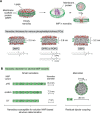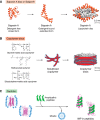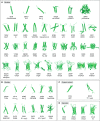Solution NMR: A powerful tool for structural and functional studies of membrane proteins in reconstituted environments
- PMID: 31551353
- PMCID: PMC6827292
- DOI: 10.1074/jbc.REV119.009178
Solution NMR: A powerful tool for structural and functional studies of membrane proteins in reconstituted environments
Abstract
A third of the genes in prokaryotic and eukaryotic genomes encode membrane proteins that are either essential for signal transduction and solute transport or function as scaffold structures. Unlike many of their soluble counterparts, the overall structural and functional organization of membrane proteins is sparingly understood. Recent advances in X-ray crystallography, cryo-EM, and nuclear magnetic resonance (NMR) are closing this gap by enabling an in-depth view of these ever-elusive proteins at atomic resolution. Despite substantial technological advancements, however, the overall proportion of membrane protein entries in the Protein Data Bank (PDB) remains <4%. This paucity is mainly attributed to difficulties associated with their expression and purification, propensity to form large multisubunit complexes, and challenges pertinent to identification of an ideal detergent, lipid, or detergent/lipid mixture that closely mimic their native environment. NMR is a powerful technique to obtain atomic-resolution and dynamic details of a protein in solution. This is accomplished through an assortment of isotopic labeling schemes designed to acquire multiple spectra that facilitate deduction of the final protein structure. In this review, we discuss current approaches and technological developments in the determination of membrane protein structures by solution NMR and highlight recent structural and mechanistic insights gained with this technique. We also discuss strategies for overcoming size limitations in NMR applications, and we explore a plethora of membrane mimetics available for the structural and mechanistic understanding of these essential cellular proteins.
Keywords: G-protein–coupled receptor (GPCR); amphipol; bicelle; membrane mimetic; membrane protein; micelle; nanodisc; nanotechnology; nuclear magnetic resonance (NMR); structural biology.
© 2019 Puthenveetil and Vinogradova.
Conflict of interest statement
The authors declare that they have no conflicts of interest with the contents of this article.
Figures








Similar articles
-
Nanodiscs for Structural Biology in a Membranous Environment.Chem Pharm Bull (Tokyo). 2019;67(4):321-326. doi: 10.1248/cpb.c18-00941. Chem Pharm Bull (Tokyo). 2019. PMID: 30930435 Review.
-
Beyond detergent micelles: The advantages and applications of non-micellar and lipid-based membrane mimetics for solution-state NMR.Prog Nucl Magn Reson Spectrosc. 2019 Oct-Dec;114-115:271-283. doi: 10.1016/j.pnmrs.2019.08.001. Epub 2019 Aug 26. Prog Nucl Magn Reson Spectrosc. 2019. PMID: 31779883 Review.
-
Assembly of phospholipid nanodiscs of controlled size for structural studies of membrane proteins by NMR.Nat Protoc. 2018 Jan;13(1):79-98. doi: 10.1038/nprot.2017.094. Epub 2017 Dec 7. Nat Protoc. 2018. PMID: 29215632 Free PMC article.
-
From Nanodiscs to Isotropic Bicelles: A Procedure for Solution Nuclear Magnetic Resonance Studies of Detergent-Sensitive Integral Membrane Proteins.Structure. 2016 Oct 4;24(10):1830-1841. doi: 10.1016/j.str.2016.07.017. Epub 2016 Sep 15. Structure. 2016. PMID: 27618661 Free PMC article.
-
Solid-state NMR structures of integral membrane proteins.Mol Membr Biol. 2015 Aug-Dec;32(5-8):156-78. doi: 10.3109/09687688.2016.1139754. Epub 2016 Feb 8. Mol Membr Biol. 2015. PMID: 26857803 Review.
Cited by
-
Exploring the World of Membrane Proteins: Techniques and Methods for Understanding Structure, Function, and Dynamics.Molecules. 2023 Oct 19;28(20):7176. doi: 10.3390/molecules28207176. Molecules. 2023. PMID: 37894653 Free PMC article. Review.
-
Deciphering Structure-Function Relationship Unveils Salt-Resistant Mode of Action of a Potent MRSA-Inhibiting Antimicrobial Peptide, RR14.J Bacteriol. 2022 Dec 20;204(12):e0031222. doi: 10.1128/jb.00312-22. Epub 2022 Nov 15. J Bacteriol. 2022. PMID: 36377870 Free PMC article.
-
Methods and Applications in Proteins and RNAs.Life (Basel). 2023 Mar 1;13(3):672. doi: 10.3390/life13030672. Life (Basel). 2023. PMID: 36983828 Free PMC article.
-
Time-Resolved Fluorescence Anisotropy from Single Molecules for Characterizing Local Flexibility in Biomolecules.J Vis Exp. 2025 Apr 25;(218):10.3791/67802. doi: 10.3791/67802. J Vis Exp. 2025. PMID: 40354236 Free PMC article.
-
Solution NMR investigations of integral membrane proteins: Challenges and innovations.Curr Opin Struct Biol. 2023 Oct;82:102654. doi: 10.1016/j.sbi.2023.102654. Epub 2023 Aug 3. Curr Opin Struct Biol. 2023. PMID: 37542910 Free PMC article. Review.
References
-
- Ernst R. R., Bodenhausen G., and Wokaun A. (1987) Principles of Nuclear Magnetic Resonance in One and Two Dimensions, Oxford University Press, Oxford, UK
-
- Wuthrich K. (1986) NMR of Proteins and Nucleic Acids, John Wiley & Sons, New York
Publication types
MeSH terms
Substances
Associated data
- Actions
- Actions
- Actions
- Actions
- Actions
- Actions
- Actions
- Actions
- Actions
- Actions
- Actions
- Actions
- Actions
- Actions
- Actions
- Actions
- Actions
- Actions
- Actions
- Actions
- Actions
- Actions
- Actions
- Actions
- Actions
- Actions
- Actions
- Actions
- Actions
- Actions
- Actions
- Actions
- Actions
- Actions
- Actions
- Actions
LinkOut - more resources
Full Text Sources
Miscellaneous

